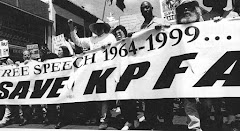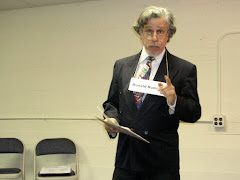In September 1948, when delegates to the new United Nations met at the
grand Palais de Chailot in Paris, a twenty-something American wearing the flak
jacket of a bomber pilot pitched a tent on the Palais steps. Guards
descended and angrily ordered him to leave, but he politely declined. I’m no longer
in France, the young man explained, eyes twinkling. I’m standing on “international
territory.”
As a crowd gathered, so did the world press. With days the name of this
pilot-turned-peacenik, Garry Davis, was known around the world. Newsreels
captured a mounting drama that featured curious crowds, inspired celebrities
and perplexed authorities.
When a reporter asked Davis what he was about, he replied, “I’m a world
citizen.” With that simple assertion a global movement was born.
Garry Davis was
part rebel, part performer and completely original, a world-class Don Quixote
who for more than half a century jousted at one of the biggest windmills of all –
nationalism. It was a wild ride that took him around the world, in and out of 34
jails, and across countless frontiers.
After renouncing his US citizenship as an anti-war protest, camping out
in Paris, and crashing a UN session to deliver a speech, Davis launched his
first major organizing project, a registry for world citizens. More than a million
people responded to the call. Forced out of France, he next went on tour,
stateless and without documents. This time thousands of people turned out to
meet him and local governments passed supportive resolutions. Yet, over the next few years he was also repeatedly
thrown in jail and deported.
In 1953, for example, while he was appearing as an actor in a London
stage production of Stalag 17, the
show closed unexpectedly when the Queen died, and Davis found himself without a
visa. A kindly magistrate gave him an idea: build a home on public property.
But he was arrested anyway and taken to Brixton prison.
Officials there laughed at first when Davis wrote to the new Queen. But
they had to eat some crow when she responded with a thank you note. She would not
step in, Her Majesty explained. But she did appreciate his situation.
Three years later, wearing a homemade uniform and carrying a “World
Passport” he had printed himself, Davis traveled to India. Necessity was
helping him to become adept at intimidating low-level bureaucrats and
exploiting the local media. His discussions with border officials were often hilarious,
exposing the arbitrary rules and artificial boundaries of nations. But once inside
country, he shifted focus to study with a Buddhist guru. The break also helped
clarify his mission and prepare him for the next phase of the journey.
At this point, for Davis, world government already existed. After all,
he had announced its formation in a 1953 declaration. Before a small audience
in Ellsworth, Maine, he had called it the World Government of World Citizens,
and explained that its legitimacy was based on three laws – one God, one world,
and one humankind. And although he was only one person, all humans were
potential world citizens. They just needed to “claim their rights and assume
their responsibilities.” Yet Davis also
understood that many more people would have to reach the same awareness before things began to change.
In the early years, the tactics Davis used sometimes put not only his freedom
but his life at risk. A year after his stay in India, for instance, Davis was
almost shot before he could show his passport in Germany. It happened in Berlin
after he left his bicycle near a barbed wire fence that separated East from West.
Crawling under the wire in a pre-dawn mist, he was caught by several gun-toting
police, arrested, interrogated, and ultimately put on a train to West Germany.
As the scenery passed he could not help but remember another view of the
same countryside --- from the cockpit of his bomber during the war – and also what
the experience had taught him. “We are born as citizens of the world,” he realized.
“But we are also born into a divided world, a world of separate entities called
nations. We may regard each other as friends, and yet we are separated by wide,
artificial boundaries.”
Garry Davis spent the rest of his life trying to change that. One of
his main strategies was to develop and issue documents, including the extraordinary
World Passport. Recognized on a case-by-case basis by more than 100 countries –
and officially by a handful – the passport has evolved into a convincing
document in seven languages, issued to at least a million people over the years. Davis often argued that the right to travel, outlined in the passport, was
grounded in the Universal Declaration of Human Rights.
Just as important as the fundamental right involved, however, was
knowing how to use tools like the passport and other identity documents. As explained in Passport to Freedom, a book we co-authored in 1991, many nations
have accepted World Passports and other documents issued by the World Service
Authority, the non-profit organization Davis founded. But step one in effectively using
them is to know what you are talking about. “The official, as part of the
machine, knows little more than his narrow function and the regulations on
which it is based. When you ask questions, you shift the burden of
responsibility.”
Other steps include remaining cool, going to the top of the chain of
command as soon as possible, always assuming you are right, keeping track on
your paperwork, choosing the right words, looking good, and remaining firm. It’s
basic, but solid advice for anyone forced to deal with arbitrary authority.
That said, over the years Davis refined the approach into a long-running piece of
political performance art that he repeatedly took around the world.
In April 1984, for example, he arrived at Tokyo’s Narita Airport. At
this point Davis was already in his 60s and could look like an elder statesman
if he wished. Determined as ever, he was nevertheless detained after a mind-boggling
exchange and told he could not enter the country. The next night, however,
when the authorities attempted to put him on a return flight, he protested so effectively
that the captain threw him off the plane.
A day later he escaped from detention and went downtown for public
interviews at a daily newspaper.
When he was caught, the Japanese put Davis in detention, then on a plane for
Seattle. There he was told that he would be placed on trial for entering the US
illegally. He was now classified as an “excludable alien,” the officials
claimed. It was beginning to look like he was trapped in a Kafka-like tale.
Two weeks after setting out for Japan, Davis stood before a US immigration
judge. Both governments were refusing to admit him. ‘Quite a dilemma,” mused
Judge Jones. But before he could decide how to handle the convoluted case, a
telex arrived from Washington, DC. The news was almost inconceivable: Davis’
entire file had somehow been “lost.”
As a result the Seattle case was closed and the world citizen was free to go.
Five years later Davis was back in Japan. This time he opened an office
in Tokyo and helped many undocumented workers and Chinese students who were
fleeing repression. For them the World Passport and other documents meant proof
of identity, access to a job, or a way to get from one place to another.
During this extended visit, Davis met the Japanese Prime Minister and
had a private, personal talk with Andrei Sakharov. The Cold War was winding
down then, and the Soviet Union would soon dissolve. Like Davis, Sakharov had
reached the conclusion that it was time to move beyond nationalism and create a
democratic world government.
After more than a year of looking the other way, however, Japanese
Immigration eventually decided to pounce and had Davis arrested in July 1990. He
was jailed for several weeks and questioned each day by the same immigration
official who had handled his original case more than five years earlier. Gradually,
Davis managed to convince this man his claim to world citizenship made sense.
The Japanese deported him anyway.
When Davis landed in Los Angeles in August 1990, he fully expected to
be arrested again. This time he was handled a letter instead. It announced that
the Secretary of State had unilaterally decided to classify him as a “parolee
in the public interest” and let him go.
During this period Davis moved to Vermont, a safe haven that remained his home for
the rest of his life. However, he never stopped fighting for his vision for a world
without borders. In July 2013, just a week before he died on July 24, just shy of 92 years old, Davis was still finding ways to spread the word. At this point NSA whistleblower Edward Snowden was
trapped in a Moscow airport after his US passport was revoked. For Davis the response was obvious: the
World Service Authority would issue him one.
The World Passport may not have reached Snowden*, but Davis made
his point one last time. “All we're doing is conforming to the idea that human rights must be
protected by law," he told reporters. "The world passport opens the
door. Anyone can get it; everyone is a human being, everyone has a right to
travel.'"
* It did reach contacts in Russia near Snowden, according to WSA's David Gallup, but whether Snowden received it wasn't confirmed.
Greg Guma knew Garry Davis for
more than 20 years, co-authoring and editing two of his books, Passport to Freedom: A Guide for World Citizens and Dear
World: A Global Odyssey. A memorial
service for Davis was held at Burlington City Arts in Burlington, Vermont on
January 5, 2014.







































